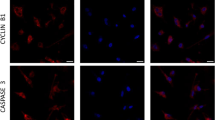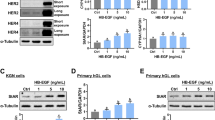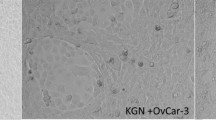Abstract
Objective
Ovarian surface epithelium (OSE), the precursor of the epithelial ovarian carcinomas, has limited growth potential in culture. Epidermal growth factor+hydrocortisone (EGF+HC) enhances its growth but induces epitheliomesenchymal transition (EMT). This study was undertaken to define the effects of EGF+HC and their reversibility, to optimize growth-promoting media, and to relate OSE phenotypes in vitro to physiologic states in vivo.
Methods
OSE was cultured in media 199/MDCB105 or EBM (Clonetics) with 2% or 10% fetal bovine serum with or without 10 ng/mL EGF, 1.0 Lg/mL HC, and 1.0 μg/mL bovine brain extract. Growth rates and growth potentials (population doublings [PD] to senescence) were defined, and growth patterns and expression of keratin and collagen types III and IV were compared with the ovarian cancer cell lines OVCAR3 and SKOV3.
Results
EGF+HC increased growth potentials from 12-14 PD to 40-42 PD and reduced PD time from 53 hours to 20 hours. Without EGF+HC, OSE cells remained uniformly epithelial. EGF+HC induced EMT (mesenchymal shapes, reduced keratin, and production of collagenous extracellular matrix), but the EMT response varied greatly among OSE from different women. EMT was reversed over 1-2 weeks by subculture into EGF+HC free medium in passage 1, but inconsistently thereafter. EGF+HC had no effect on the differentiation of ovarian carcinoma lines.
Conclusion
The phenotype of intact OSE in vivo is most closely reproduced in media without EGF+HC. EGF+HC enhances growth but initiates EMT, which likely mimics a repair response. Variations in EGF+HC-induced phenotypes point to the existence of OSE subpopulations with differing responsiveness to growth factors or steroids, which may relate to their susceptibility to malignant transformation.
Similar content being viewed by others
References
Auersperg N, Wong AS, Choi KC, Kang SK, Leung PC. Ovarian surface epithelium: Biology, endocrinology, and pathology. Endocr Rev 2001;22:255–88.
Kruk PA, Auersperg N. Human ovarian surface epithelial cells are capable of physically restructuring extracellular matrix. Am J Obstet Gynecol 1992;167:1437–43.
Kruk PA, Uitto VJ, Firth JD, Dedhar S, Auersperg N. Reciprocal interactions between human ovarian surface epithelial cells and adjacent extracellular matrix. Exp Cell Res 1994;215:97–108.
Kruk PA, Maines-Bandiera SL, Auersperg N. A simplified method to culture human ovarian surface epithelium. Lab Invest 1990;63:132–6.
Auersperg N, Maines-Bandiera L. Culture and characterization of human ovarian surface epithelium. In: Bartlett JMS, ed. Methods in molecular medicine. Totowa, NJ: Humana Press, 2000: 169–74.
Maines-Bandiera SL, Kruk PA, Auersperg N. Simian virus 40-transformed human ovarian surface epithelial cells escape normal growth controls but retain morphogenetic responses to extracellular matrix. Am J Obstet Gynecol 1992;167:729–35.
Tsao SW, Mok SC, Fey EG, et al. Characterization of human ovarian surface epithelial cells immortalized by human papilloma viral oncogenes (HPV-E6E7 ORFs). Exp Cell Res 1995;218:499–507.
Auersperg N, Ziltener H. Re: Reproductive hormone-induced, STAT3-mediated interleukin 6 action in normal and malignant human ovarian surface epithelial cells. J Natl Cancer Inst 2002;94:1255–6.
Siemens CH, Auersperg N. Serial propagation of human ovarian surface epithelium in tissue culture. J Cell Physiol 1988;134:347–56.
Rodriguez GC, Berchuck A, Whitaker RS, Schlossman D, Clarke-Pearson DL, Bast RC Jr. Epidermal growth factor receptor expression in normal ovarian epithelium and ovarian cancer. II. Relationship between receptor expression and response to epidermal growth factor. Am J Obstet Gynecol 1991;164:745–50.
Berchuck A, Rodriguez GC, Kamel A, et al. Epidermal growth factor receptor expression in normal ovarian epithelium and ovarian cancer. I. Correlation of receptor expression with prognostic factors in patients with ovarian cancer. Am J Obstet Gynecol 1991;164:669–74.
Berchuck A, Kohier MF, Bocnte MP, Rodriguez GC, Whitaker RS, Bast RC Jr. Growth regulation and transformation of ovarian epithelium. Cancer 1993;71:545–51.
Gillet JY, Maillet R, Gautier C. Blood supply and lymph supply of the ovary. In: Motta P, Makabe E, eds. Biology of the ovary. Boston: Martinus Nijhoff Publishers, 1980:86–98.
Maruo T, Ladines-Llave CA, Samoto T, et al. Expression of epidermal growth factor and its receptor in the human ovary during follicular growth and regression. Endocrinology 1993;132:924–31.
Jindal SK, Snoey DM, Lobb DK, Dorrington JH. Transforming growth factor alpha localization and role in surface epithelium of normal human ovaries and in ovarian carcinoma cells. Gynecol Oncol 1994;53:17–23.
Doraiswamy V, Parrott JA, Skinner MK. Expression and action of transforming growth factor alpha in normal ovarian surface epithelium and ovarian cancer. Biol Reprod 2000;63:789–96.
Reeka N, Berg FD, Brucker C. Presence of transforming growth factor alpha and epidermal growth factor in human ovarian tissue and follicular fluid. Hum Reprod 1998;13:2199–205.
Klapper LN, Kirschbaum MH, Sela M, Yarden Y. Biochemical and clinical implications of the ErbB/HER signaling network of growth factor receptors. Adv Cancer Res 2000;77:25–79.
Soltoff SP, Carraway KL III, Prigent SA, Gullick WG, Cantley LC. ErbB3 is involved in activation of phosphatidylinositol 3-ki-nase by epidermal growth factor. Mol Cell Biol 1994;14:3550–8.
Wells A. EGF receptor. Int J Biochem Cell Biol 1999;31:637–43.
Carpenter G. The EGF receptor: A nexus for trafficking and signaling. Bioessays 2000;22:697–707.
Maihle NJ, Baron AT, Barrette BA, et al. EGF/ErbB receptor family in ovarian cancer. Cancer Treat Res 2002;107:247–58.
Durant S, Duval D, Homo-Delarche F. Factors involved in the control of fibroblast proliferation by glucocorticoids: A review. Endocr Rev 1986;7:254–69.
Ponec M. Effects of glucocorticoids on cultured skin fibroblasts and keratinocytes. Int J Dermatol 1984;23:11–24.
Zhang XY, Pettengell R, Nasiri N, Kalia V, Dalgleish AG, Barton DP. Characteristics and growth patterns of human peritoneal mesothelial cells: Comparison between advanced epithelial ovarian cancer and non-ovarian cancer sources. J Soc Gynecol Investig 1999;6:333–40.
Elliott WM, Auersperg N. Comparison of the neutral red and methylene blue assays to study cell growth in culture. Biotech Histochem 1993;68:29–35.
Dyck HG, Hamilton TC, Godwin AK, Lynch HT, Maines-Bandiera S, Auersperg N. Autonomy of the epithelial phenotype in human ovarian surface epithelium: Changes with neoplastic progression and with a family history of ovarian cancer. Int J Cancer 1996;69:429–36.
Haskell MD, Slack JK, Parsons JT, Parsons SJ. c-Src tyrosine phosphorylation of epidermal growth factor receptor, PI90 RhoGAP, and focal adhesion kinase regulates diverse cellular processes. Chem Rev 2001;101:2425–40.
Hauck CR, Sieg DJ, Hsia DA, et al. Inhibition of focal adhesion kinase expression or activity disrupts epidermal growth factor-stimulated signaling promoting the migration of invasive human carcinoma cells. Cancer Res 2001;61:7079–90.
Kawahara E, Nakada N, Hikichi T, Kobayashi J, Nakanishi I. EGF and betal integrin convergently regulate migration of A431 carcinoma cell through MAP kinase activation. Exp Cell Res 2002;272:84–91.
Lu Z, Jiang G, Blume-Jensen P, Hunter T. Epidermal growth factor-induced tumor cell invasion and metastasis initiated by dephosphorylation and downregulation of focal adhesion kinase. Mol Cell Biol 2001;21:4016–31.
Pichard V, Honore S, Kovacic H, et al. Adhesion, actin cytoskel-eton organisation and the spreading of colon adenocarcinoma cells induced by EGF are mediated by alpha2betal integrin low clustering through focal adhesion kinase. Histochem Cell Biol 2001;116:337–48.
Wells A, Kassis J, Solava J, Turner T, Lauffenburger DA. Growth factor-induced cell motility in tumor invasion. Acta Oncol 2002;41:124–30.
Lamande SR, Bateman JF. Procollagen folding and assembly: The role of endoplasmic reticulum enzymes and molecular chap-erones. Semin Cell Dev Biol 1999;10:455–64.
Hulmes DJ. Building collagen molecules, fibrils, and suprafibrillar structures. J Struct Biol 2002;137:2–10.
McCawley LJ, O’Brien P, Hudson LG. Epidermal growth factor (EGF)- and scatter factor/hepatocyte growth factor (SF/HGF)-mediated keratinocyte migration is coincident with induction of matrix metalloproteinase (MMP)-9. J Cell Physiol 1998;176:255–65.
Kucharz EJ. Hormonal control of collagen metabolism. Part II. Endocrinologie 1988;26:229–37.
Mahonen A, Jukkola A, Risteli L, Risteli J, Maenpaa PH. Type I procollagen synthesis is regulated by steroids and related hormones in human osteosarcoma cells. J Cell Biochem 1998;68:151–63.
Talts JF, Weller A, Timpl R, Ekblom M, Ekblom P. Regulation of mesenchymal extracellular matrix protein synthesis by transforming growth factor-beta and glucocorticoids in tumor stroma. J Cell Sci 1995;108(Pt 6):2153–62.
Wicke C, Halliday B, Allen D, et al. Effects of steroids and retinoids on wound healing. Arch Surg 2000;135:1265–70.
Colige AC, Lambert CA, Nusgens BV, Lapiere CM. Effect of cell-cell and cell-matrix interactions on the response of fibroblasts to epidermal growth factor in vitro. Expression of collagen type I, collagenase, stromelysin and tissue inhibitor of metalloprotein-ases. Biochem J 1992;285(Pt 1):215–21.
Ma H, Zhang Z, Tong T. The effects of epidermal growth factor on gene expression in human fibroblasts. In Vitro Cell Dev Biol Anim 2002;38:481–6.
Lee EH, Kao WW, Schwarz RI. Cell density regulates prolyl 4-hydroxylase activity independent of mRNA levels. Matrix Biol 2001;19:779–82.
Lafrenie RM, Bernier SM, Yamada KM. Adhesion to fibronectin or collagen I gel induces rapid, extensive, biosynthetic alterations in epithelial cells. J CeU Physiol 1998;175:163–73.
Author information
Authors and Affiliations
Corresponding author
Additional information
Supported by a grant (to N.A.) from the National Cancer Institute of Canada, with funds from the Canadian Cancer Society.
We thank Dr. R. Schwarz, Lawrence Berkeley Laboratory, for helpful and inspiring discussions.
Rights and permissions
About this article
Cite this article
Salamanca, C.M., Maines-Bandiera, S.L., Leung, P.C.K. et al. Effects of Epidermal Growth Factor/Hydrocortisone on the Growth and Differentiation of Human Ovarian Surface Epithelium. Reprod. Sci. 11, 241–251 (2004). https://doi.org/10.1016/j.jsgi.2003.10.010
Published:
Issue Date:
DOI: https://doi.org/10.1016/j.jsgi.2003.10.010




